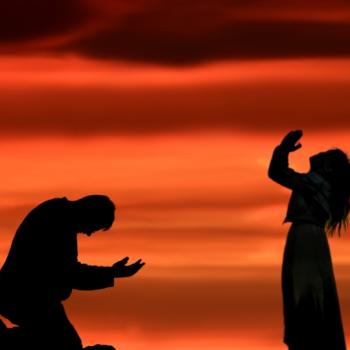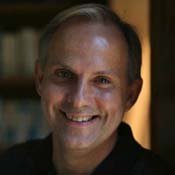Not many holy people get the bumper sticker treatment. There was St. Francis in the '60s, oft-presented as a hippie treehugger who loved everything and everybody. There was Mother Teresa, improbably quoted and poster-ized.
But above all, there is St. Nicholas, a creature of modern pop culture as much as Christian history, known worldwide for decades through the advertising of the CocaCola corporation. As with the case of St. Francis's appropriation by the Earth movement (Google "St. Francis" and "hippie" and see how many angry Catholics you find), the core identity of St. Nicholas of Myra, the actual historical Christian, can get lost in cultural accretions, as inspirational as they might be. Who was St. Nicholas, patron saint of children, patron saint of sailors, our primary image of gift-giving and generosity?
Adam C. English, a Professor at Campbell University, has tracked down what can be known about this shadowy figure in The Saint Who Would Be Santa Claus. (Full disclosure: I was asked by Baylor University Press to endorse the book, and after reading it, did so. This review corresponds to that positive early reading.) What can we learn about a figure so shrouded in myth that we sometimes confuse two saints for the same man? Although they lived two hundred years apart, Nicholas of Sion and Nicholas of Myra are still sometimes confused by modern authors, since they were conflated in a 10th-century saint's compendium.
Moreover, unlike some early figures in the Church, Nicholas of Myra didn't leave behind letters, books, or sermons as Ambrose, Augustine, and Jerome did to mark their path. Some major reference works even suggest that despite his omnipresence in religious art and religious legend, there is little to no evidence for the historicity of St. Nicholas. One of Professor English's primary tasks thus is to argue that there was an actual St. Nicholas—and then to argue that his real life, his role as Christmas elf aside, is worthy of study. This he does admirably.
As Professor English points out, the life of Nicholas spans one of the central moments in Christian history, when the Roman Empire converted to Christianity: "All of the growing pangs of this conversion process manifested themselves in the life of Nicholas. His was a life of faith, to be sure, but it was also one of adventure and honor, justice and charity, goodwill and thick resolve." (17-18) Like Augustine, his life is set against a dramatic historical backdrop that is also a chief factor in the person—the saint—he becomes.
Nicholas is most noted for a radical act of generosity—giving money to a poor family so that their daughters had money for their dowries. In a world where credit was unknown and many people were on the knife-edge of disaster, Nicholas' gifts may have been the difference between happy and prosperous lives for these daughters and prostitution. So his generosity is an act of real humanity as well as holiness. Unlike other holy men of that time, Nicholas in this act suggests the importance of marriage instead of simply affirming ascetic celibacy. Marriage—the lot of most people—is a thing to be welcomed and blessed, not disdained as somehow unworthy.
Later artists, as Professor English notes, will depict Nicholas as simultaneously holy and human. In Raphael's Ansidei Madonna, Nicholas stands on one side of the Virgin and Child, John the Baptist on the other, but while John is otherworldly and the Madonna so serene as to be untouchable, Raphael has painted Nicholas as a distinctly approachable character. "In the holy presence of Jesus, Mary, and John the Baptist," Professor English writes, "Nicholas is approachable, likeable—dare we say—friendly. Despite the high formality of the Renaissance style, Raphael has painted everything we love about Nicholas." (76)
What makes this book and its story of Nicholas compelling is its recognition throughout of that combination of the human and the holy. Nicholas was a real bishop and a real Christian living in a real world in flux, and he seems so in the stories and pictures of the age.
So many of our saints seem in their depictions to be ascetic athletes: they have arrows sticking from their unflinching bodies, or they are looking upward, always upward, instead of around at a world in need. Nicholas—long before he was dressed in red and trimmed in fur, long before he was thought to pop down chimneys rewarding good children with gifts—was a person who at once inspired wonder and who seemed the sort of saint one could emulate. Even more so than other saints, Nicholas was "knowable, relatable, and approachable" in ways that God was not. (147) This most accessible and human of saints is a person who can teach us how real faith might look, and it's a joy that The Saint Who Would Be Santa Claus is as engaging and inspiring as its subject.
12/2/2022 9:10:33 PM





